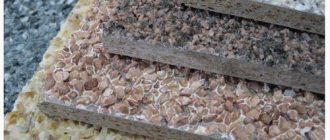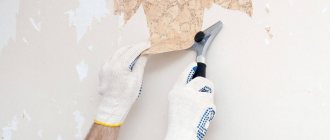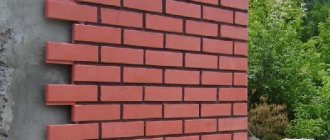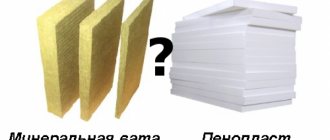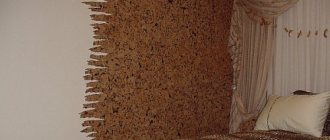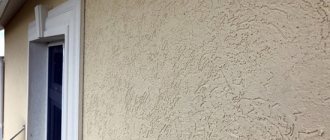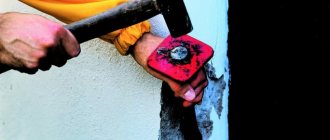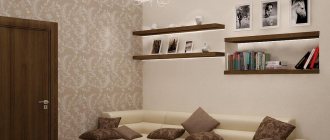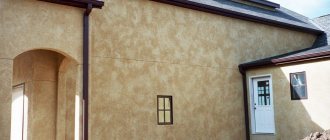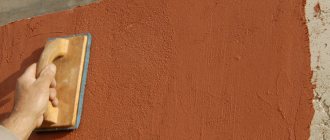People say that repairs are like a fire. Therefore, homeowners try to use reliable, durable materials. One of these is elastic plaster, the use of which helps solve several problems at the same time. The flexible, tensile coating does not crack when the house shrinks, does not allow water to pass through to the structures it protects, and strengthens weak foundations while serving as a decorative feature.
Description and history of appearance
It would seem that everyone is happy with classic mineral plasters. However, they are not able to withstand vibrations from nearby trains, weak seismic influences and slight shrinkage of the building. They once earned recognition for their non-shrinkability during hardening. In fact, they are low-elastic, and, unable to withstand such operating conditions, they quickly become covered with cracks and cease to serve as protection for the building’s structures.
In the middle of the twentieth century, chemists invented artificial resins, among which acrylic resins stand out for their flexibility after hardening. Acrylic resin can absorb up to 70% of the filler.
The created modified acrylic liquid began to be used not only in the production of plastic, but also to create artificial stone. And artists began to experiment with creating paints based on it. The composition of such paints was simple: water, acrylic, pigment. To obtain a plaster solution, all that remained was to add a mineral filler.
The mixtures obtained on an acrylic basis formed a flexible, elastic coating that did not crack during the shrinkage of the building, which solved the problem of protecting the walls. It remained to slightly modify the composition using functional additives in order to eliminate the existing shortcomings.
This plaster was quickly dubbed rubber. The coating can be bent and slightly stretched up to 10% of the initial length without compromising its integrity. Later, silicone-based compositions began to be produced, however, elastic plasters have an acrylic base.
Fillers for elastic composition of natural or artificial origin:
- sand (including quartz);
- fibers;
- stone chips;
- granules.
The appearance of the elastic coating, depending on the filler used, may resemble plaster or other textures of decorative solutions. Elastic mixtures are available in ready-made or dry form. They can be tinted or serve as a base for tinting.
Features of plastering – 3 layers
Mortar for plastering walls is easy to make with your own hands. It is necessary to level the surface. This operation is required both for external and internal finishing. The characteristics and requirements depend on the place where the essence is applied. Thus, to carry out repair work indoors, you will need a technologically advanced and plastic mass, while external mixtures must first of all be resistant to changes in pressure and temperature, frost-resistant and resistant to moisture.
Solutions are applied to surfaces of all types and types. Plastering of plywood, chipboard sheets, wooden elements, cinder blocks and foam concrete, brickwork, and concrete is carried out. When making a suitable composition at home, it is very important to pay attention to the adhesion of the finished product when choosing components and proportions.
The correct technology for applying plaster to the ceiling and walls includes three main stages:
- The spray is the first layer that needs to be applied to the building base. It is necessary to fill and level the largest pores and surface defects, as well as to ensure an appropriate level of adhesion and cohesion of subsequent plaster layers. When forming it, additional elements, such as lime and clay, are not used, and the thickness of the coating should not exceed 4 mm.
- The second level, which is called soil, is significantly larger in volume than the previous one and reaches 20 mm. Unlike liquid spray, this layer’s consistency is more consistent with thick plastic dough. Its task is to maximally level the base plane, regardless of its roughness.
- The last stage of work is the application of a coating to the surface, which is required for the final smoothing of unevenness and defects in the base. The thickness of the layer is from 3 to 5 mm, and enough water is added to achieve the maximum level of plasticity and viscosity of the solution. After covering, all that remains is to whitewash or paint the walls or glue decorative wallpaper on them.
Elastic plaster: advantages and disadvantages
Main advantages:
- compressibility and extensibility without compromising the integrity of the coating;
- forms a coating without seams;
- vapor permeability, allowing the wall material to breathe;
- no toxic emissions;
- the service life of a properly executed coating is more than 10 years;
- fire resistance;
- temperature limits from -50 to +60°C;
- color fastness, not afraid of UV rays;
- quick drying;
- serves as barriers to fungi and mold;
- easy to clean with plain water;
- adheres well to almost all substrates (this is especially valuable for “playing” wooden structures);
- universal application;
- easy to apply and shape;
- hydrophobic, protects walls from water ingress;
- does not dry out the skin (you can work without gloves);
- does not splash when applied to the wall, does not drip from the spatula;
- Suitable for repairing cracked walls and finishing new buildings.
The downside so far is the high cost.
Specifications
Flexible plaster, in addition to other technical characteristics inherent in finishing compositions, has a new one - linear stretching.
On average, the technical parameters are as follows:
- density – not less than 1400 kg/m3;
- adhesion (in relation to concrete) > 0.3MPa;
- compressive strength, expansion strength – 7 bar;
- final strength is gained after 3 days;
- linear stretch from +10% per sq.m;
- contains more than 50% non-volatile substances;
- consumption - 0.3-2.8 kg/m2;
- air and base temperature during application + 5, + 30°C; during operation -50, +60 °C;
- frost resistance - more than 150 cycles;
- salt resistance ~ 300 hours of exposure;
- water permeability - less than 8g/hour per square meter;
- service life more than 10 years.
Where is elastic plaster used?
The elasticity of the coating serves as the basis for choosing these particular compositions for buildings experiencing vibration, as well as for new buildings that have not yet gone through a period of shrinkage. Taking into account the hydrophobic properties, flexible plaster is preferable for facades, as well as wet rooms, for example, bathrooms, basements, baths, swimming pools.
The ability not only to stretch, but also to shrink, makes it popular for use on landings, corridors, and halls. Elastic compositions are good for finishing finishing when insulating buildings using wet (plaster) systems.
Most often, elastic plaster is produced and used as facade plaster. However, as can already be understood from the above, it is also successfully used for interior work. It can be used to cover gypsum stucco with a thin layer, as well as figured products made of polyurethane or polystyrene foam. The rubber compound is also used to cover walls that have many joints, seams and joints, for example, made of CBPB, creating a seamless coating. Can be used as an adhesive base for linoleum, parquet, and carpet.
Mortar for plastering walls - how to make the mixture with your own hands?
Plastering is an integral stage of any repair work. Thanks to this process, the consumer properties of the treated surfaces are improved, and the reliability and durability of the walls is increased. High-quality prepared and correctly applied plaster prevents the spread of mold and fungi, removes all irregularities, chips and mechanical defects, and also helps strengthen the base.
Plastering is an integral stage of any repair work. Thanks to this process, the consumer properties of the treated surfaces are improved, and the reliability and durability of the walls is increased. High-quality prepared and correctly applied plaster prevents the spread of mold and fungi, removes all irregularities, chips and mechanical defects, and also helps strengthen the base.
Types of elastic plasters
Rubber plaster is available in two types:
- decorative;
- acrylic.
The main task of the acrylic mixture is to protect walls and other structures. It also maintains the integrity and continuity of the coating (which is ensured by acrylic base polymers). The task of decorative flexible plaster is different. It is also intended for decorating various surfaces. This effect is achieved due to the shape and size of the filler grains (with simple even application), as well as by methods of treating the surface of the applied layer.
Mixtures with filler of different fractions are produced, as well as mixtures with reinforcing polymer threads.
Possible decorative effects of coatings:
- fur coat;
- imitation gypsum;
- lamb;
- bark beetle and others.
You can use tinted compounds to decorate walls using the sgraffito technique. Patterned relief is applied with figured rollers or other devices.
Surface primer
Before priming the surface of the wall, it must be cleaned of old coating: wallpaper, oil paints, whitewash. After all, if you leave them, the new coating will not have reliable adhesion to the wall, and the plaster will fall off.
Removing the old coating also helps to identify the presence of defects. After removing the coating, the wall is vacuumed to remove dust. The protrusions are cut down, chips and cracks are covered. Large damages are repaired using reinforcing mesh. Oil stains must be removed. Fungal and mold outbreaks are also removed. For this purpose, biocidal solutions are used. Metal parts are coated with insulating compounds. The screws securing the DSP boards to the wall are recessed by 1-2 mm.
Wall materials, such as concrete, brick, foam blocks, are full of small and large pores. To prevent them from drawing out the water that the plaster needs for hardening reactions to occur, as well as to obtain reliable adhesion, they are coated with primer compounds twice with intermediate drying. After the primer has dried, if it is necessary to level the surface of the base, it is puttied (minimum thickness - 2 mm), or plastered over the beacons.
If there are joints on the wall (for example, DSP boards or insulation), then they are sealed with elastic sealants and the surface of the seams is leveled with the surface of the boards.
What is useful for kneading - let's move on to the tools
Mixing all the components of the solution is carried out in two ways - machine and manual. The easiest way to prepare the mixture is in a regular enamel bucket or other similar container. Having added cement and sand and mixed everything thoroughly, all that remains is to pour in water in small portions and continue to knead the composition using available tools.
If you need to make a large volume of solution, it is recommended to use a special trough or bath. Here, blunt shovels or bayonet shovels, as well as choppers with a flat base, are used to mix the components. To simplify the process somewhat, experts advise performing the movements on yourself, otherwise your arms and lower back will get tired too quickly.
If you have a construction mixer, it greatly simplifies the work. The nozzle is any suitable element, be it a curved wire or a blade. Concrete mixers also make it easier to mix the solution, but their use is only advisable if the volume of plaster is very large.
Source
Surface reinforcement
Elastic plaster is usually applied in a thin layer, so the surface of the base is covered with cement mortar. If you need to make the leveling layer durable, use reinforcement mesh.
Basic rules for installing a grid:
- fasten to the wall using dowels or an adhesive solution, making sure that there are no sagging (where sagging is left, air pockets appear under the plaster);
- the mesh panels are connected by overlapping the joined edges;
- after fixing the grid, beacons are installed;
- apply a leveling solution and level;
- after the beginning of setting, the beacon strips are removed and the remaining grooves are sealed.
stirring the mixture
installation of reinforcing mesh
applying elastic plaster
result of applying elastic plaster
How to make your own supplements?
If you want to save money, then instead of factory additives for plasticity, you can add plasticizers prepared by yourself to the cement mortar:
- Slaked lime: in addition to increasing elasticity, it has bactericidal properties and protects against the appearance of fungus, increases adhesion and crack resistance. When finishing brick houses built back in Soviet times, fluff lime was used.
- Liquid soap or washing powder dissolved in water. Extend setting time.
- PVA glue: also increases the water resistance and strength of concrete mixtures.
Application of elastic plaster for facades
Always from the center of the wall towards the edges - from wet to dry, as well as wet to wet - this is the basic rule for applying elastic compounds.
Before starting work, stir the finished mixture (if bubbles form, the solution is allowed to settle). The dry mixture is kneaded following the manufacturer's instructions (see instructions).
Elastic plaster is applied manually or using a plastering machine. In both cases, the wall is processed completely in one go. There should be no breaks.
For manual application, the rubber compound is applied to the base by positioning the trowel or putty knife plate at a 60-degree angle to the wall. When the laid mortar stops sticking to the tool, it is smoothed or structured with a trowel, holding it parallel to the layer.
Smoothing with a spatula or trowel after half an hour leads to the formation of a glossy surface. This is how a coating similar to Venetian is made. The solution is applied in two or three layers (the first is continuous, the next two are applied in separate strokes using the Venetian technique).
During the decorative treatment of the layer, as well as during the drying period, the layer cannot be moistened.
Another way to apply a flexible solution is to roll it with a textured roller. It is carried out from the bottom up, then rolled horizontally to evenly distribute the mixture on the wall.
Rubber solutions quickly set and polymerize. Therefore, work on large areas is carried out in teams. If two people are plastering a wall, then they move from the corners of the wall towards the center (toward each other).
Tools and parts of the plastering machine are washed with water after use.
Paint the surface with acrylic paints after the rubber layer has dried.
If you plan to purchase already painted mortar, then purchase the material from one batch so that the entire wall is the same color. Lots may differ in shades.
What components are needed to prepare the mixture?
Many beginners, trying to make a plaster solution with their own hands, disrupt the mixing process from the very beginning. This is very important, since the key characteristics of the finished composition depend on high-quality and correct mixing. The main components include water, filler and binder. If necessary, additional materials are introduced, including various additives and plasticizers.
Clay and lime can play the role of a binder. But the most popular and in demand is cement. It is excellent for preparing a mixture that is later used for exterior or interior decoration. At the same time, it is the most expensive option, since the other ingredients are seriously inferior to it in terms of quality, reliability and strength.
When choosing among many varieties, the easiest way is to choose M400 cement. This dry mixture is universal because it meets all the requirements of GOST, as well as apartment owners. Excellent for treating bathrooms, kitchens, hallways and, of course, living rooms. If the budget is limited, and repairs are carried out in low-impact structures, such as basements or plinths, then a rational solution would be to purchase M300 Portland cement.
The strength of plaster is influenced by many factors, but the most important is the brand of cement. The higher this indicator, the better the quality of the solution.
For exterior decoration, experts recommend giving preference to products designated M500. Such products showed their best performance in conditions of high humidity and constant temperature changes.
Having decided on the binder, all that remains is to deal with the filler. Here the only and undisputed favorite is ordinary sand. It is recommended to take pure river fine fraction, which will ensure maximum mixing of all the ingredients of the future plaster. Together with cement, it forms an ideal material characterized by resistance to cracking and a high level of strength.
The simplest and most popular proportion for preparing a cement-based plaster mixture includes one part of binder and three parts of sand. This recipe is suitable for almost any room. Water is added until the essence reaches the required viscosity level. For rooms with normal moisture levels, you can add a little more filler. If you want to achieve plasticity, then the correct ratio involves using one portion of cement and two parts of sand.
There are many plasticizers and additives designed to increase the softness and pliability of the finished plaster, change the hardening time and various characteristics of the solution. Home craftsmen often add detergents, soaps, and adhesives like PVA. Thanks to such materials, the adhesion of the essence to the concrete base improves, and the level of protection against fungal bacteria and mold increases.
A big misconception is associated with the technology of mixing the mixture. For some “experts,” the order in which components are added does not matter. Many people first pour water into a container, then pour in cement, sand, lime and other materials. The problem is that the dry substance, after entering the liquid, turns into small lumps. It will take a lot of effort to stir them until the desired consistency is achieved.
In order for the solution to be high-quality and homogeneous, experienced craftsmen advise performing the following steps:
- Initially, you need to sift the sand using a sieve with small cells. Otherwise, all debris and large particles such as shells, pieces of silt, pebbles, and organic debris will end up in the solution. During plastering, they will leave grooves on the surface of the wall, clinging to the spatula.
- After this, you need to pour dry cement into the sand and mix everything thoroughly. If the filler is wet, it will need to be dried - mixing will be much easier when both components are dehydrated.
- Only after this is water added, and gradually, while the solution itself is constantly mixed. It is recommended to pour in new portions of liquid at a time when it is almost impossible to interfere.
Leading manufacturers
Elastic plaster for facades, as well as interiors, is supplied to the market by Russian and foreign manufacturers.
The following compositions can be distinguished:
- i-Flex is a universal-purpose elastomeric ready-made decorative mixture with a filler fraction of 0.7-1.2 mm. The coating can stretch up to 15%. Manual/mechanical application. Bayramix.
- ST-79 is an elastomeric decorative pebble composition for plinths, parking lots, garage entrances, reinforced with a complex of polyacrylamide, carbon fibers, and also fiberglass. The composition contains silicone modifiers. Grain 1.5 mm. Extended operating temperature range. Zeresit.
- Capa-Rollputz-Flex is a ready-made façade mortar with a grain size of 0.4-1.5 mm. Caparol.
- Multiflex - two types Nano and Nano lux - ready-made decorative, waterproofing compounds for universal use. These materials are distinguished by their tensile strength (106% nano, 200% nanolux) and adhesion to concrete – 1.6 MPa. White color. Application by brush or roller. Suitable for covering swimming pool bowls. Polymer Megapolis.
Operational care
The elastic cover is easy to use. The flexible coating does not attract dust, resulting in virtually no contamination. Therefore, the surface does not need to be cleaned frequently. Wash the walls with plain water or soap and water. For cleaning, use a cloth, sponge or nylon brush.
By using elastic plaster for the facades and/or interiors of a house, they solve a number of problems at once: they protect the walls from water penetration, strengthen the weak surface of the insulation, and decorate the room or facade. The remaining solution can be used for gluing parquet or linoleum.
